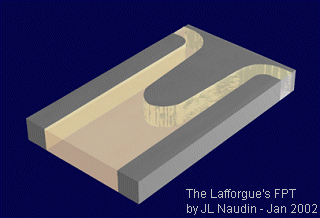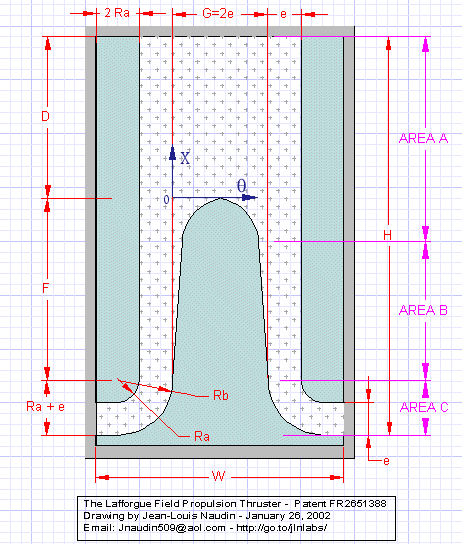

The
Lafforgue's Field Propulsion Thruster Solver
By
Jean-Louis Naudin
created on
February 1, 2002 - JLN Labs -
Last update February 4, 2002
All
informations in this page are published free and are intended for
private/educational purposes and not for commercial applications

Drawing
not to scale

Drawing
not to scale
The Lafforgue's FPT
solver v2.01 - By JL Naudin - Updated February 4, 2002
( JavaScript must be enabled in your browser
)
Note: This new solver uses an improved version ( more accurate ) of the Lafforgue's original equation, if want to use the old solver version which uses the original Lafforgue's equation presented in his patent you may click here.

Click here to see all the details about the
Lafforgue's theory and its principle

| Material | Dielectric constant ( K ) | Dielectric Strength ( V/m ) |
| Air | 1.00059 | 3e6 |
| Teflon | 2.1 | 60e6 |
| Styrene HIPS | 2.56 | 24e6 |
| Nylon | 3.00 | 14e6 |
| Bakelite | 3.7 | 24e6 |
| Kapton | 4.2 | 11.8e7 |
| Neoprene rubber | 6.7 | 12e6 |
| Strontium Titanate | 233 | 8e6 |
| Barium Strontium Titanate ( BaSrTiO3 ) | 13800 | 10e7 |
I encourage anyone who wants to conduct
some researches in this domain, to study the Lafforgue's patent FR2651388 very
carefully....
Some translations of the Lafforgue's patent can be found here.
|
|||||||||||
 The
LFPT explained : Theory and Principle
The
LFPT explained : Theory and Principle
![]() Email : JNaudin509@aol.com
Email : JNaudin509@aol.com
Return to the LFPT home page